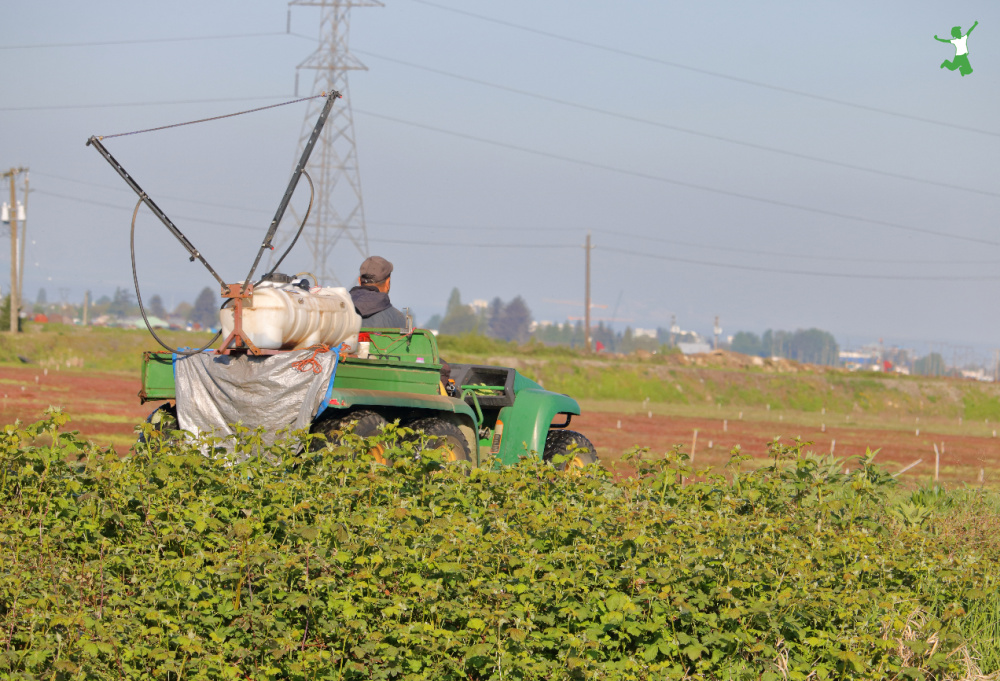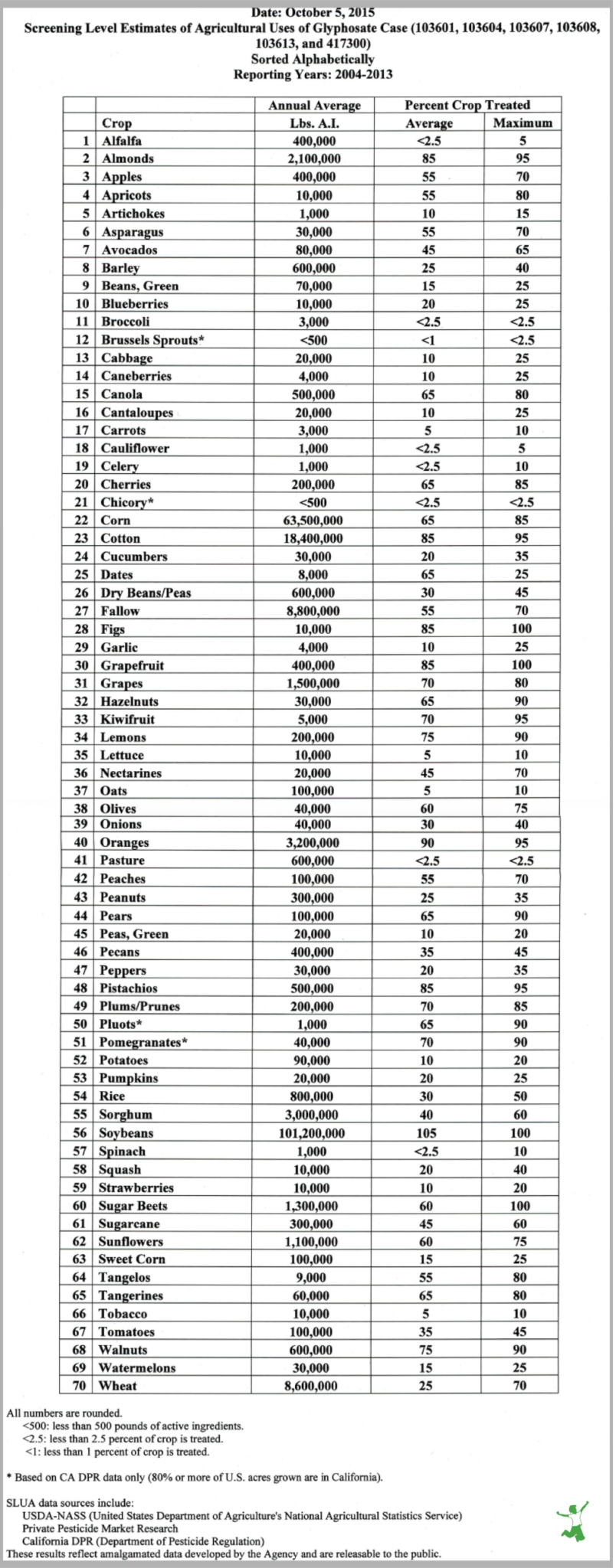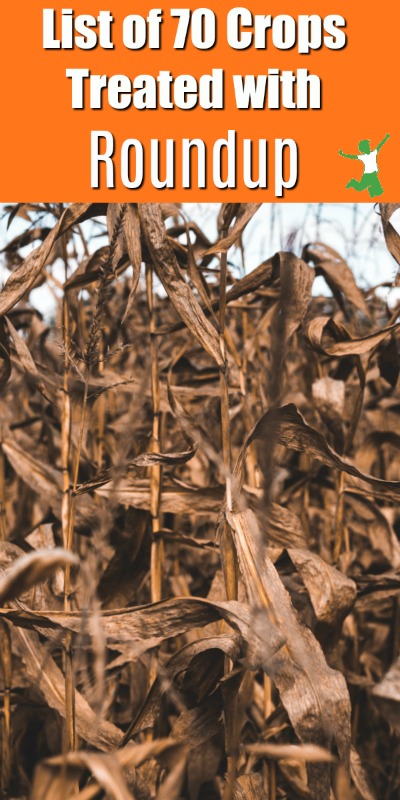Application of herbicides containing the toxic chemical glyphosate (Roundup) is common for dozens of conventional food crops, in many instances, just before harvest. The problem is not just wheat crops as commonly believed.

The application of herbicides as a (toxic) drying agent on wheat immediately before harvest is an established practice on many conventional farms.
The method was first suggested as early as 1980, becoming routine in North America over the past 15 years or so. Use is also widespread in the UK.
Applying herbicides like Roundup 7-10 days before harvest is viewed as especially helpful for wheat that ripens unevenly, a common occurrence.
It is also considered a helpful tool to initiate an earlier harvest when weather conditions threaten plant viability.
Other benefits are earlier ripening for earlier replanting and reducing the green material in the field. This puts less strain on farm machinery during harvest.
Farmers euphemistically call the practice “desiccation”. When used during wheat harvesting, it can result in a slightly greater yield by triggering plants to release more seeds.
The result?
Most non-organic wheat in North America is now contaminated with glyphosate, the active ingredient in Roundup and similar herbicides.
Glyphosate is Carcinogenic
A March 2015 report by the World Health Organization identified glyphosate as a probable human carcinogen. (1)
Several EU countries have banned Roundup as a result.
However, in North America, glyphosate use shockingly continues to remain popular in the conventional farming community.
As it turns out, the use of Roundup as a drying agent on wheat prior to harvest is just the tip of the iceberg.
Dozens of other food crops are subjected to dousing with glyphosate just prior to harvest as well.
This misguided and dangerous practice maximizes the herbicide residue on the food itself for the humans that eventually eat it!
Roundup. Not Just for GMO Crops
It is well known that Roundup is sprayed directly on GMO crops like corn and soy because they are genetically engineered to withstand the toxic onslaught without withering.
In fact, so much Roundup is used on GMO crops that herbicide-resistant “superweeds” are now a huge problem little more than a decade later. (2)
“If Roundup kills plants that aren’t genetically modified to resist it, then why use it on nonGMO crops?”
“Wouldn’t glyphosate kill a nonGMO crop?”
“Why would a farmer do this?”
Indeed, these common consumer questions indicate the ultimate irony of using Roundup for desiccation purposes on a food crop producing farm.
Killing the crop and/or the greenery around it is actually the whole idea. For crops like wheat, it evens up the field, allows for an earlier harvest, protects machinery and/or increases profit.
The bottom line?
Pre-harvest treatment of crops with glyphosate helps farmers to harvest their crops more efficiently and at less cost.
Crazy as it may seem, Roundup is used everywhere in the North American conventional food supply and not just on GMO crops or to kill weeds!
Glyphosate is applied directly to dozens of nonGMO food crops, in many cases, right before they are harvested.
This is the worst possible time to apply a herbicide because it causes the glyphosate to be absorbed into the food crop directly.
In other words, the glyphosate can’t be washed off later as it has become part of the food.
This toxin will then be ingested by those who consume it either directly as a “whole food” or via processed foods that contain it as an ingredient.
According to the Cornucopia Institute:
Ubiquitous in food production, glyphosate is used not just with row crops like corn, soybeans and wheat but also a range of fruits, nuts and veggies. Even spinach growers use glyphosate. (3)
Desiccating crops with herbicides before harvest is catching on in the UK as well where summers are wet and crops may ripen slowly and unevenly.
This can potentially lead to reduced yields and a lower-quality crop.
For example, 78% of the UK oilseed rape crop (similar to canola) is desiccated before harvest, but only 4% in Germany. (4)
Common Crops Desiccated with Glyphosate
The list of common crops desiccated with glyphosate within a few days of harvest is shockingly long!
Seventy crops are on the current EPA list which runs from 2004-2013. The complete list of crops is shown in the images below taken from an EPA memo from October 2015. (5)
What’s more, when the list is compared with a prior data snapshot, it shows that glyphosate use by farmers for key food crops alarmingly continues to grow. (6)
Glyphosate use by farmers averages 70% or more for some crops.
These include almonds, walnuts, figs, plums, prunes, grapes, kiwi, lemons, grapefruit, pistachios, and pomegranates.
Note: I could not find a more recent list than 2004-2013. However, given the results of glyphosate testing by Moms Across America in the past couple of years, it seems the list has expanded rather than contracted! More on this below.

How Glyphosate Destroys the Immune System
The currently accepted view is that glyphosate is not harmful to humans or any mammals.
This flawed view is so pervasive in the conventional farming community that Roundup salesmen have been known to foolishly drink it during presentations!
Just because Roundup doesn’t kill you immediately doesn’t make it safe though! The health-robbing effects are actually slow and insidious over months and years.
The decline in health occurs because glyphosate lethally disrupts the shikimate pathway found in beneficial gut microbes.
This probiotic pathway is responsible for the synthesis of critical amino acids and the cytochrome P450 (CYP) enzymes.
CYP enzymes are used by the body to detoxify the multitude of foreign chemical compounds and xenobiotics.
No matter where we live, we are exposed to these toxins in our modern environment every single day.
As a result, people exposed to glyphosate residue through the ingestion of food crops treated with it just before harvest become even more vulnerable to the damaging effects of other chemicals and environmental toxins they encounter!
This is possibly the worse result of glyphosate exposure. It makes you a sitting duck for any other toxins you encounter.
In addition, by significantly disrupting the functioning of beneficial bacteria in the gut, permeability issues related to the intestinal wall can occur over time.
This slow degradation of gut function encourages the development of a myriad of autoimmune disease symptoms.
These diseases include celiac disease, food allergies, Crohn’s, IBS, asthma, ulcerative colitis, MS, lupus, eczema, cancer, and the list goes on and on.
Glyphosate Million Dollar Question
Hence the chicken and egg question:
Is gluten in the wheat really the problem or is it actually the glyphosate residue sprayed on the wheat?
The same can be said for other foods.
Is it really the food(s) that are triggering an autoimmunity problem or the glyphosate that is being sprayed on it?
How Much Roundup Residue Are We Eating?
Consumers are increasingly alarmed by the monstrous rise in the use of glyphosate-containing herbicides on food crops.
In the United States, they are calling for testing of residues to determine if the levels are safe. Such testing is done for other agrichemicals, why not Roundup?
Unfortunately, while the FDA supposedly began testing for glyphosate residue in food in 2016, the results are questionable at best. (7)
Fortunately, private groups are filling the data gap, and the results are eye-opening.
For example, Moms Across America has found shocking levels of Roundup residue in processed food. Most recently, chickpea pasta was tested with the highest amount of glyphosate ever recorded. (8)
Note that chickpeas aren’t even on the Roundup crop list above 🤯
Thus, the complete list of foods with gut-damaging Roundup residues is far longer than believed.
The reality is that your only protection is to insist on organically produced food as much as possible.
And….for non-organic produce, be sure to buy it from local farmers ONLY with whom you are familiar with their growing practices.
The list of crops desiccated with glyphosate is far too long (and seemingly more extensive than is being revealed) and the risk to health far too high to consider otherwise.
(1) Widely Used Herbicide Linked to Cancer
(2) EPA Watchdog to Investigate Monsanto GMOs and Superweeds
(3) How Widespread Is the Use of Glyphosate in Our Food Supply?
(4) Glyphosate Renewal Group
(5) EPA Memo: Updated Screening Level Usage Analysis (SLUA) Report for Glyphosate Case PC
(6) EPA Memo: Updated Screening Level Usage Analysis (SLUA) Report in Support of Registration Review of Glyphosate
(7) FDA to Start Testing for Glyphosate in Food
(8) Moms Across America: Data on Toxins









I don’t understand how they could spray glyphosate on many crops and not damage the fruit. If you spray your strawberry bed to kill the green plant, would it not also kill the berries? The only possibility I can think of is that they spray it on the fruit to make it ripen. Do you know what they use as a ripening agent?
does soaking walnuts and almonds help?
I haven’t seen any research that it does. I personally would not count on it. Buy organic if you possibly can!
This article makes the need for a small (or bigger) backyard/front yard garden so important.
YES!!!
I buy Weat Montana flour. I contacted them about glyphosate use. The company does not use it. The spokesperson said that the arid nature of Montana makes that unnecessary. You can buy there flour at Walmart.
Thanks for sharing your research and what a great tip!
What is the brand name? I have found organic bread flour, but not soft wheat & certainly no corn.
Can you share your sources on the impact of glyphosate on the gut bacteria?
This article contains details and references from the MIT researcher who discovered this terrible truth about glyphosate. https://www.thehealthyhomeeconomist.com/roundup-quick-death-for-weeds-slow-and-painful-death-for-you/
I live near Mexico and have many produce warehouses nearby because of our proximity to the Mexican growers. The local food banks give us many of these Mexican grown items. Do you know if this produce is likely to be just as contaminated?
I think you may have written about this before. I used to buy the King Arthur whole wheat flour but switched to organic after reading about this. I also read somewhere that organic wines have been tested to have glyphosate in them. It makes me wonder how safe organic food really is, at least the stuff in the grocery store. I also wonder how I will ever get healthy!
Exactly. The point is that we shoppers cannot determine what is safe and what is not. I have been Keto for 8 years. It is not safe. Cattle and swine are fed a lot of corn – the crop most sprayed by glyphosates & gmo. The insecticide in gmo corn reacts to acid of the insect bites. The plant produces the insecticide itself. (Chemical reaction). Sadly it does the same in the animal stomach. So the animal is not only exposed to glyphosate but also toxins manufactured 8n their own bodies. It is pernicipus. Couldnt be any more harmful if it was designed to be. And I think it probably was. For decades the FDA has allowed companies to get away with no labels on packages for these horrible farming practices.
Sarah, the practice of dessication on GMO crops to increase yield and to dry the crop to make it easier to harvest makes no sense at all. GMO crops are supposed to be roundup/glyphosate resistant. This appears to be a non sequitur, and a riddle to really look into!
I’ve read other articles that the wheat in particular is sprayed to stop it from further growth. Spray at the prime moment for maximum yield and you can harvest a vast field without having to rush to avoid spoilage. Nice idea, horrible practice. We buy from a local farm and I’m able to tolerate the wheat with minimal issues unlike many commercial wheat.
Just because one field doesn’t treat doesn’t mean the end product isn’t contaminated. As with corn, RR corn can be mixed with non GMO Field corn in the silos that go to processing
Kimberly, most wheat is NEVER sprayed with glyphosate, even just before harvest. It is not needed and spraying will NOT increase yield for the number of kernels (seeds) is determine 6 to 8 weeks before the grain ripens. The data Sarah shows does not show applications before harvest . Most roundup is used in fallow ground for weed control up to 24 months before harvest. I have grown only wheat on my farm for the last 40 years, and the wheat grown I the USA is safe. Thank you
Crop desiccation is done with non-GMO crops. GMO crops are sprayed to kill weeds and bugs but the plant is resistant.
Sarah,
Thanks for doing this article! I am one of the few people, like you, that believe the Glyphosate is the problem, not the gluten.
And several of those are on the supposed “clean 15” list. There are very few organic choices in my small town. We live on a small farm where we raise our own pastured meats, eggs, dairy, and some veggies, all organically. The rest I’ll just have to travel out of town for. Thanks for the warning.
I was shocked too at the length of this list. When I first started researching for the article, I knew there were other crops that had pre-harvest Roundup applied, but thought it was only a handful. It makes the urgency of eating organic even more important for sure! Even if Roundup is the only chemical applied to the “Clean 15”, it is too much.
Ladies, only 4 of the crops are 100% sprayed. You can still get the crops without roundup on all the rest.
Here’s the problem David. As a consumer, unless you buy ALL your foods – veggies, nuts, fruits, grains and all directly from a specific farm where you know the farmer personally and can ask about the chemicals used, you have no idea if they were sprayed with glyphosate or not!
If a food crop that you use in your home is on that list of 70 as being desiccated with glyphosate and you see it at the store and it isn’t organic, you really have no idea if it has glyphosate residue or not. Best to just not buy these foods if they were conventionally grown!
With wheat … even though the average farm desiccates 25% of the crop, it contaminates the rest as it is all mixed in.
Sarah, the chart you show says nothing about preharvest use of glyphosate or when it is applied. It is unclear what this chart shows as it says “estimates” and there is no direct link to see how data was gathered. USDA-NASS pesticide surveys cover the pesticide use for the entire crop year ( from day after last harvest to harvest of current crop). Could you please tell me what line 27 on the chart means? Fallow? Is that a crop??? Thank you, Roger
It will be interesting to see what the FDA finds when it starts testing for glyphosate residue this year. In the UK, they are already finding glyphosate residue in bread and other foods made with wheat.
Robin, if you adopted a ketogenic diet, which can be a very healthy diet, based on what you currently ;harvest from your farm, then you are 95% of the way to a very healthy diet and only need to add a few greens.